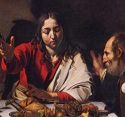Principles of Color - Artists
Written: Sep 13 2005, revised 8/8/2011, by Donna YoungAbout This Week
During the time that we used Alpha Omega Press LifePac Electives Art, Unit Two, we took a few days at the end of the unit to study artists and their use of color and light in their work. This was a bit of art history mixed in with reinforcing her lessons on color effects and color schemes (also called color harmonies).
Many artists used dramatic light effects and colors in their paintings. This week my daughter will read about four artists and look at photographs of their art. We used books, for your convenience, I will link to ibiblio
 Monday:
Rembrandt
Monday:
Rembrandt
We started with Rembrandt as the opener artist. He is more commonly
known than some of the other artists that we will read about this week. He is know for dramatic use of light and shadow.
http://www.ibiblio.org/wm/paint/auth/rembrandt/
Rembrandt is featured in Gallery 4
 Tuesday:
Caravaggio
Tuesday:
Caravaggio
A trailblazer - I like his " Supper at Emmaus " and it is featured in Gallery 4
http://www.ibiblio.org/wm/paint/auth/caravaggio/
Wednesday: Vincent van Gogh
Read about artist, look at certain paintings and tell what
type of palette was used.. (complementary colors, split-complementary,
analogous, monochromatic ) - See Assignment Example Below
Web site linked below is a resource for
paintings.
http://www.ibiblio.org/wm/paint/auth/gogh/
Thursday: Edward Hopper
Do the same as yesterday
Web site linked below is a resource for
paintings.
http://www.ibiblio.org/wm/paint/auth/hopper/
 Friday: Jan Vermeer
Friday: Jan Vermeer
The same as yesterday.
Web site linked below is a resource for
paintings.
http://www.ibiblio.org/wm/paint/auth/vermeer/
Assignment Example
Below are two examples of Color Harmonies.
Complementary Palette
This work by Vincent Van Gogh was inspired by Jean-Franois Millet's engraving of peasants.
Noon: Rest From Work 1889-90, Muse d'Orsay, Paris
Primarily painted with blues and oranges.

Split Complementary Palette
Irises 1890
Painted with blues and yellow-oranges.



 Coordinate Grid Paper
Coordinate Grid Paper Unlock A Cell Sometimes
Unlock A Cell Sometimes


